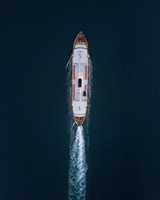New insights into pressure exerted on marine ecosystems in the Med – Sep 10, 2020
Maritime traffic and offshore oil and gas exploration and production constitute important drivers of marine pollution in the Mediterranean. The Study on trends and outlook of marine pollution from ships and activities and of maritime traffic and offshore activities in the Mediterranean conducted by REMPEC, jointly with three other UNEP/MAP system components (namely Plan Bleu, MED POL and SPA/RAC) compiles the best available knowledge on four aspects: pollution from oil and chemicals, marine litter, air pollution, non-indigenous species and underwater noise.
In addition to identifying gaps related to data collection and proposing measures to ensure compliance with reporting obligations under the Barcelona Convention and its Protocols, the study will support efforts to achieve the Good Environmental Status of the Mediterranean (GES). It feeds into relevant Ecological Objectives and Common Indicators of the Integrated Monitoring and Assessment Programme (IMAP)—the Mediterranean region’s first common instrument developed by UNEP/MAP for harmonized monitoring and assessment underpinning the pursuit of GES.
Sneak peek into the findings
- In the last decade passenger traffic increased significantly (1.5 times) while port calls related to merchant shipping increased by 15.2 per cent.
- An important number of old offshore platforms are approaching the end of operational lifetime in the Mediterranean. Their decommissioning has environmental implications that require adequate measures.
- Up to 1,500-2,000 events of operational oil spill are estimated to occur yearly in the basin. The distribution of oil spills is well correlated with major shipping routes, crossing the Mediterranean from east to west and linking major ports.
- Kostianoy and Carpenter (2018) suggests 50,000-100,000 tons per year as possible estimation of volume of oil illicitly discharged every year.
- It is estimated that a million tons of marine litter originates from ships in the Mediterranean.
- Up to 57 per cent of all emissions from international shipping in Europe occur in the Mediterranean Sea.
- Changes in Mediterranean marine biodiversity related to introduction of non-indigenous species (NIS) are attributed to intense maritime traffic, opening of corridors and aquaculture farming (among other activities).
- In the last decade, the species richness of marine organisms in the Mediterranean Sea has been reported to have reached ∼17,000 taxa (a measure of biological diversity, among which some 820 can be considered non-indigenous species.
- Background noise levels in Mare Nostrum are higher than in any other ocean basin. Ship noise and seismic surveys are among the primary sources of noise that can lead to behavioral disturbances, loss of hearing and mortality of marine species.
The next steps
REMPEC is currently facilitating a consultation among the Contracting Parties to the Barcelona Convention on the study. A complementary technical report on maritime traffic outlook for the next five, ten and thirty years (2025, 2030, 2050) is being carried out.
Based on the findings, strategic and operational measures will be integrated into the Mediterranean Strategy for the Prevention of, and Response to Marine Pollution from Ships (2022-2031) and its Action plan. REMPEC is taking the lead on the development of the draft Strategy and its Action Plan, which will be submitted to COP 22 Barcelona Convention for adoption.
The Outlook section of the study will contribute to the preparation of the Mediterranean 2023 Quality Status Report (2023 MED QSR) and the MED 2050 Foresight Study towards a shared vision on a sustainable Mediterranean in 2050.
The Study on trends and outlook of marine pollution from ships and activities and of maritime traffic and offshore activities in the Mediterranean will be published following its review by the Fourteenth Meeting of the Focal Points of REMPEC, to be tentatively held in Malta, between 25 and 27 May 2021.


